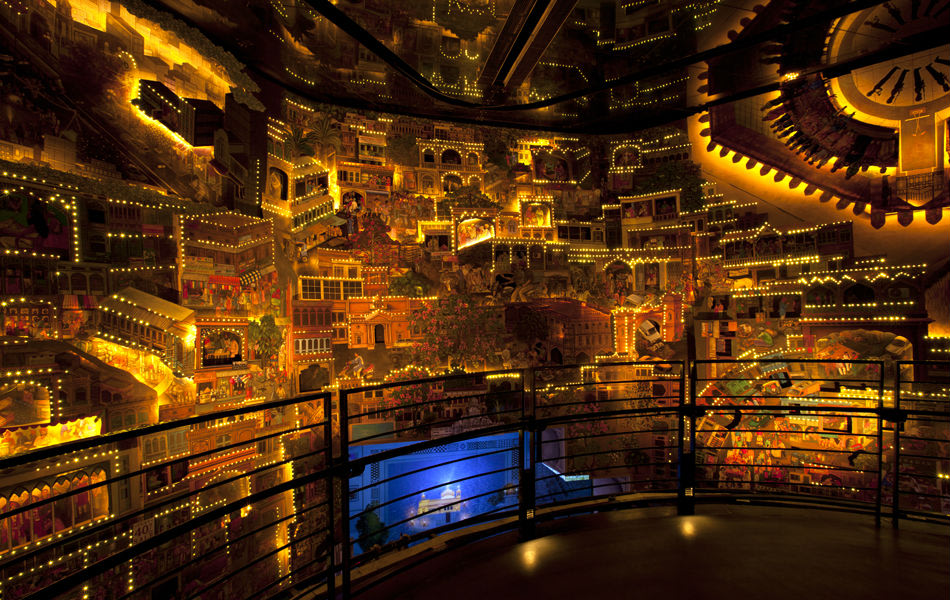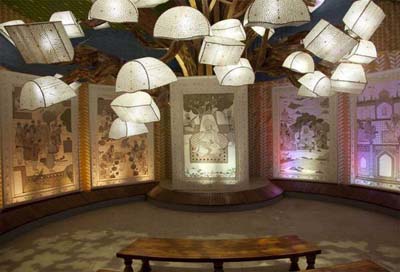BY: JENNY FORD
The title of this blog post seems rather impossible. If there’s not one there has to be the other, right? Without objects or text, doesn’t that just give us an empty museum?
 |
| The Virasat-e-Khalsa Museum. Source. |
Two weeks ago, I had the pleasure of sitting in on a talk from George Jacob, currently the president of the Philip J. Currie Museum in Grand Prairie, Alta. In a former role, Jacob was the first director of Virasat-e-Khalsa, a religious museum in the state of Punjab in India, which opened in 2011. The museum traces 500 years of Sikh history. The massive complex has 14 galleries all without a single word or artefact.
NO TEXT, NO STUFF, NO PROBLEM
So, how does the museum get away with this? Jacob described how he and his team chose to concentrate on custom art and symbolism, audio guides, and on-site interpreters to help get the messages across to the public. This helped get around issues of multiple languages, varying dialects, and avoiding the museum becoming a potential religious shrine if it had objects.
 |
| The giant 360-mural in the first gallery. Source. |
The first gallery, for instance, features a giant hairpin walkway surrounded by an intricate 360-mural that depicts the history of the community and the religion. Visitors are led through the mural's stories with the help of an audio guide. Another gallery relies on symbolism to tell the story of the martyrdom Guru Arjun, who was roasted alive when he wouldn’t stop preaching. The gallery features an empty wok and stylized smoke, representing this story.
Although those from the Sikh community may be able to pick out the symbols and piece together the interpretive messages, it's true others may be a bit lost. To overcome this issue, the museum provides gallery attendants and audio guides for more information.
 |
| Gallery 5 for Guru Nanak. Source. |
DOING MORE WITH LESS
Some of these notions have been thrown around before in museums. In Steven Conn’s book Do Museums Still Need Objects?, he discusses how museums are moving away from 'things' to programs. Museum are focussing on creating other experiences that are no longer object driven. Furthermore, many disciplines (art history aside) are no longer reliant on objects to tell their stories like they were in the past. Technology has also redefined how interpretation and curation can be done, diversifying the toolbox to engage the public and create meaning.
 |
| The missing and murdered women installation at the CMHR. Source: Jenny Ford |
Although not strictly object-free, the Canadian Museum for Human Rights (CMHR) has very few artifacts on display and relies mostly on art, symbolism, and technology to engage and educate audiences. In its Canadian Journeys Gallery, alcoves rely on custom-made art to tell different human rights stories. One alcove uses red dresses hanging in a forest to represent the stories of Missing and Murdered Women. However, there is text to explain the symbolic displays.
 |
| The Albis: Sigmar Polke 1963-2010 at MoMA has no text. Source. |
On the other side, art museums have long played with the decision of “to label or not to label”, especially as content seems to be increasingly politicized. In many of the Art Gallery of Ontario’s galleries, for instance, labels are absent from cases and walls in favour of cards with tombstone information that visitors can pick up if they so desire. The art is not obstructed by text but perhaps provides more opportunity for reflection and personal meaning-making.
Thanks to all the readers and the Musings team! Signing off from my final post.


No comments:
Post a Comment
Note: only a member of this blog may post a comment.